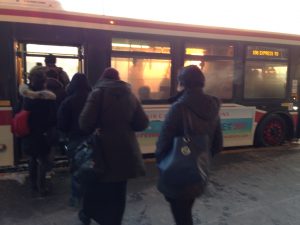By Michael Collens, Sean Hertel and Roger Keil
What is transit equity and how can we ensure we get it as we roll out major transit investments in the Greater Toronto and Hamilton Area (GTHA)? A report and expert workshop led by York University’s Greater Toronto Suburban Working Group (GTSWG) aim to kick start a conversation to answer these questions.
The GTHA is a large and complex region with regional transit challenges to match. It is one of the world’s preeminent and diverse metropolitan areas, projected to add over 2.5-million people and 1.5-million jobs by 2031. The planning, funding, and building of regional transit, which is overseen by the Province of Ontario’s transit agency Metrolinx and directed by the 25-year, $50-billion plan, The Big Move (2008), is as complex as the region itself.
Metrolinx is planning to build 1,200 km of rapid transit to meet current and projected transportation demands across the region. This could very well be the single greatest – and perhaps last – junction of opportunity to complete the regional transit network, and to counteract the structural inequities that have been created by, and have persisted throughout, past growth-infrastructure cycles. 
The benefits of public transit investments are not equally distributed. Like all metropolitan regions in the world, the GTHA has structural inequities created over decades, if not more than a century, of decisions being made and not made: where growth occurs; the type and density of development; where transit and other infrastructures are constructed, and; where public and private capital is invested and extracted. While the region, as a whole, stands to benefit from public transit infrastructure investments, not everyone will be a winner.
Transit investments, by their very nature, have consequences beyond the rails, rolling stock and terminals and the operations they support. They also build cities, enable communities, empower individuals to participate in society’s opportunities more fully. But they also have the power to exclude. The expression “living on the other side of the tracks” speaks to that. When making investments now, we need to strive toward “transit equity” in the future, which means cancelling out some of the “transit injustices” of the past. “Fairness” must play a role in distribution of the benefits and costs, and in a manner that is responsive to the social and economic needs of the most number of residents, and especially those most vulnerable.
Deciding transit infrastructure priorities – lines, technologies, station locations, service frequencies, budgets – preordains those who stand to win and lose from those decisions. In a review of international examples, we have found that transit investments have tended to benefit areas that are already doing well, while not changing the prospects for areas that are not. This reinforces pre-existing inequities among communities and neighbourhoods. Toronto’s past practice bears out the same reality. Will this be different this time around?
Further compounding the win-lose nature of transit investments is gentrification, which redirects transit’s economic and social benefits back in favour of those with the means to locate near the best services. This further marginalizes disadvantaged groups, who are often low income, visible minority, women, children and the elderly. Transit inequity is also correlated with, and compounded by, location. In particular, the “inbetween city” in the inner suburbs being the perennial loser. They often don’t get serviced directly as tracks, lines and routes pass them by.
It does not have to be that way. It is possible to shift from “picking winners” to creating equity. Public policy and activist interventions are able to more equitably distribute the public benefits of public transit investments. This may entail improved access to employment opportunities and services. Our review reveals that both government and citizen-led interventions have begun to bring about some degree of transit equity, or at the very least to fuel an emerging public debate around it.
To strengthen this debate, we have invited experts and the public in Toronto to embark on a conversation to identify strategies to address the “equity issue.” Those typically focus on the network (where the lines go), access (service), and price (affordability). Tools or levers deployed through various strategies might include, for example, reduced or fare-free structures, the democratization of line and service planning, and the mandated consideration of social equity as a factor in determining new or expanded services. If we don’t get this right now, we will all pay for it later.
Michael Collens is a student in the Masters in Environmental Studies program at York University, concentrating on planning for sustainability and equitability in public transportation.
Sean Hertel leads an urban planning consulting practice and is a researcher at the City Institute at York University, specializing in transit-oriented development, housing and suburbs.
Roger Keil is York Research Chair in Global Sub/Urban Studies at the Faculty of Environmental Studies at York University and Principal Investigator of the Major Collaborative Research Initiative, Global Suburbanisms: Governance, Land and Infrastructure in the 21st Century.
Images: Bellefair Urbanistik

